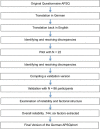Validation of a German short version of the Attitudes towards Patient Safety Questionnaire (G-APSQshort) for the measurement of undergraduate medical students' attitudes to and needs for patient safety
- PMID: 28293675
- PMCID: PMC5327660
- DOI: 10.3205/zma001085
Validation of a German short version of the Attitudes towards Patient Safety Questionnaire (G-APSQshort) for the measurement of undergraduate medical students' attitudes to and needs for patient safety
Abstract
Introduction: Topics of patient safety are being taught increasingly within medical eudcation. To date, however, there is no suitable means of measuring the status quo of medical students' attitudes towards patient safety in German-speaking Europe. The German validation of a short version of the Attitude towards Patient Safety Questionnaire (G-APSQshort) is meant to fill this gap with the aid of two validation studies. Methods: In Study 1, item and reliability analyses were used to examine internal consistency as well as factorial structure. In Study 2, the measurement sensitivity of the G-APSQshort in detecting changes in attitudes was assessed. Results: Study 1 comprised N=83 participants (M=23.16 years; 21 female). Adequate internal consistency (Cronbach's α=.722-.903) was reached in 6 of the seven subscales. The factor analysis showed that the six extracted factors matched the theoretically conceived subscales. Study 2 comprised N=21 participants (M=26 years; 11 female). A multivariate analysis of variance showed that the differences before and after a short-term intervention were significant with medium effect size (F(1;16)=6.675; p<.05; η2=.29). Discussion: In six subscales, the G-APSQshort can be considered valid in respect to measuring point and change. It is hoped that regular and concerted implementation of measuring instruments such as the G-APSQshort will help to develop a common ground for data comparison among many different German-speaking medical faculties.
Hintergrund: Zunehmend sollen Themen der Patientensicherheit auch im Rahmen des Medizinstudiums gelehrt werden. Für eine Bedarfsanalyse existiert im deutschsprachigen Raum jedoch bisher kein geeignetes Messinstrument zur Erhebung des Status Quo von Einstellungen Medizinstudierender zum Thema Patientensicherheit. Die deutsche Validierung einer Kurzversion des Attitudes towards Patient Safety Questionnaire (G-APSQshort), soll diese Lücke anhand von zwei Validierungsstudien schließen.Methode: In Studie 1 wird mittels Item- und Reliabilitätsanalysen die interne Konsistenz, sowie die faktorielle Struktur überprüft. In Studie 2 wird die Messsensitivität des G-APSQshort zum Nachweis von Einstellungsveränderungen eingeschätzt.Ergebnisse: An Studie 1 nahmen N=83 Teilnehmer (M=23,16 Jahre; 21 Weiblich) teil. Von den insgesamt sieben Subskalen konnte bei sechs Subskalen ausreichende interne Konsistenz (Cronbachs α=.722-.903) erreicht werden. Die Faktorenanalyse ergab, dass die sechs extrahierten Faktoren mit den theoretisch konzipierten Subskalen übereinstimmen.An Studie 2 nahmen N=21 Teilnehmer (M=26 Jahre; 11 weiblich) teil. Eine Multivariate Varianzanalyse ergab, dass die Unterschiede vor- zu nach einer Kurzzeitintervention mit mittelgroßem Effekt signifikant geworden sind (F(1;16)=6,675; p<.05; η2=.29). Die Reliabilität der Differenzen der Messzeitpunkte war mit Cronbachs α=.615 ausreichend hoch.Diskussion: Der G-APSQshort kann in sechs Subskalen als messzeitpunkt- und veränderungsvalide gelten. Es ist zu hoffen, dass durch den regelmäßigen und konzertierten Einsatz von Messinstrumenten wie dem G-APSQshort eine gemeinsame Datenbasis vieler verschiedener deutschsprachiger medizinischer Fakultäten entsteht.
Figures




Similar articles
-
A Spanish-language patient safety questionnaire to measure medical and nursing students' attitudes and knowledge.Rev Panam Salud Publica. 2015 Aug;38(2):110-9. Rev Panam Salud Publica. 2015. PMID: 26581051
-
Development of an instrument to measure medical students' perceptions of the assessment environment: initial validation.Med Educ Online. 2015 Oct 27;20:28612. doi: 10.3402/meo.v20.28612. eCollection 2015. Med Educ Online. 2015. PMID: 26511792 Free PMC article.
-
Do medical students like communication? Validation of the German CSAS (Communication Skills Attitude Scale).GMS Z Med Ausbild. 2015 Feb 11;32(1):Doc11. doi: 10.3205/zma000953. eCollection 2015. GMS Z Med Ausbild. 2015. PMID: 25699103 Free PMC article.
-
Development of the Greifswald questionnaire for the measurement of interprofessional attitudes.GMS J Med Educ. 2020 Feb 17;37(1):Doc7. doi: 10.3205/zma001300. eCollection 2020. GMS J Med Educ. 2020. PMID: 32270021 Free PMC article.
-
German undergraduate medical students' attitudes and needs regarding medical errors and patient safety--a national survey in Germany.Med Teach. 2014 Jun;36(6):505-10. doi: 10.3109/0142159X.2014.891008. Epub 2014 Mar 5. Med Teach. 2014. PMID: 24597660
Cited by
-
Attitudes of undergraduate medical students toward patients' safety in Jordan: a multi-center cross-sectional study.BMC Med Educ. 2023 Sep 22;23(1):695. doi: 10.1186/s12909-023-04672-9. BMC Med Educ. 2023. PMID: 37740186 Free PMC article.
-
How could the topic patient safety be embedded in the curriculum? A recommendation by the Committee for Patient Safety and Error Management of the GMA.GMS J Med Educ. 2018 Feb 15;35(1):Doc15. doi: 10.3205/zma001162. eCollection 2018. GMS J Med Educ. 2018. PMID: 29497700 Free PMC article.
-
Piloting and evaluating feasibility of a training program to improve patient safety for inter-professional inpatient care teams - study protocol of a cluster randomized controlled trial.Trials. 2019 Jun 28;20(1):386. doi: 10.1186/s13063-019-3448-7. Trials. 2019. PMID: 31253188 Free PMC article.
-
The impact of an innovative curriculum to introduce patient safety and quality improvement content.BMC Med Educ. 2019 May 21;19(1):156. doi: 10.1186/s12909-019-1604-0. BMC Med Educ. 2019. PMID: 31113414 Free PMC article.
References
-
- Schrappe M. Patientensicherheit und Risikomanagement. Med Klinik. 2005;100(8):478–485. doi: 10.1007/s00063-005-1061. Available from: http://dx.doi.org/10.1007/s00063-005-1061. - DOI - DOI - PubMed
-
- Fehlerhafte Behandlungen: Tausende Patienten klagen über Medizinerpfusch. [10.10.2015];Spiegel Online. 2011 Available from: http://www.spiegel.de/wissenschaft/medizin/fehlerhafte-behandlungen-taus....
-
- SCHOCKZAHLEN! 1712 Tote durch Ärztepfusch ...und mangelhafte Medizinprodukte. Bildzeitung. 2012 Available from: http://www.bild.de/politik/inland/behandlungsfehler/tod-durch-aerztepfus....
-
- Rohe J, Heinrich AS, Thomeczek C. CIRSmedical.de: Netzwerk für Patientensicherheit. Dtsch Ärztebl. 2011;108(3):A–92, B. Available from: http://www.aerzteblatt.de/archiv/80367/CIRSmedical-de-Netzwerk-fuer-Pati....
-
- Association of American Medical Colleges. Patient Safety and Graduate Medical Education. Washington/DC: Association of American Medical Colleges; 2003. p. 27. Available from: https://members.aamc.org/eweb/upload/patient%20safety%20gme.pdf.
MeSH terms
LinkOut - more resources
Full Text Sources
Medical
Miscellaneous

